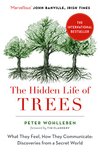
The Hidden Life of Trees: The International Bestseller

increased forest management leads to increased richness in the diversity of plant life, this is no cause for celebration but rather proof of the level of disturbance of the natural ecosystem.
Peter Wohlleben • The Hidden Life of Trees: The International Bestseller
continuous cover forests with careful selective cutting are to silviculture.
Peter Wohlleben • The Hidden Life of Trees: The International Bestseller
Large plants do not have brains, they move very slowly, their interests are completely different from ours, and they live their daily lives at an incredibly slow pace.
Peter Wohlleben • The Hidden Life of Trees: The International Bestseller
More and more people are giving up meat altogether or giving more thought to how they buy meat to promote the humane treatment of animals.
Peter Wohlleben • The Hidden Life of Trees: The International Bestseller
That means it is okay to use wood as long as trees are allowed to live in a way that is appropriate to their species.
Peter Wohlleben • The Hidden Life of Trees: The International Bestseller
Unfortunately, 95 percent of the current forest practice in Central Europe looks quite different, with the use of heavy machinery and plantation monocultures.
Peter Wohlleben • The Hidden Life of Trees: The International Bestseller
After all, we are also part of Nature, and we are made in such a way that we can survive only with the help of organic substances from other species. We share this necessity with all other animals. The real question is whether we help ourselves only to what we need from the forest ecosystem, and—analogous to our treatment of animals—whether we
... See morePeter Wohlleben • The Hidden Life of Trees: The International Bestseller
Wherever forests can develop in a species-appropriate manner, they offer particularly beneficial functions that are legally placed above lumber production in many forest laws. I am talking about respite and recovery.
Peter Wohlleben • The Hidden Life of Trees: The International Bestseller
The tree uses these openings to exhale oxygen and breathe in carbon dioxide. At night, when the tree is not photosynthesizing, it does the reverse.